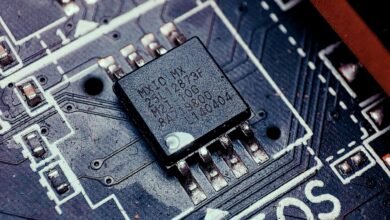eSIM vs Physical SIM: The Future of Mobile Connectivity
Compare eSIM vs Physical SIM technology. Discover advantages, compatibility, security features, and which option suits your mobile connectivity needs best.

The world of mobile connectivity is rapidly evolving, and at the center of this transformation lies a fundamental choice: eSIM vs Physical SIM. As we navigate through 2025, this decision has become increasingly important for consumers, travelers, and businesses alike. While traditional physical SIM cards have served us faithfully for decades, eSIM technology is reshaping how we connect to cellular networks.
The shift toward embedded SIM technology represents more than just a technological upgrade—it’s a complete reimagining of mobile connectivity. Major manufacturers like Apple have already embraced eSIM-only devices, with the iPhone 14 and iPhone 15 US models completely eliminating the physical SIM slot. Meanwhile, dual SIM functionality has become more accessible than ever, allowing users to maintain multiple network connections on a single device.
Understanding the differences between these two technologies is crucial for making informed decisions about your mobile connectivity needs. Whether you’re a frequent traveler seeking seamless international roaming, a business professional managing multiple numbers, or simply someone looking to future-proof their mobile setup, this comprehensive comparison will help you determine which SIM card technology aligns with your requirements and lifestyle.
What is a Physical SIM Card?
A physical SIM card (Subscriber Identity Module) is a small, removable chip that stores essential information needed to connect your device to a mobile network. These plastic cards contain your unique identifiers, including your International Mobile Subscriber Identity (IMSI) and Integrated Circuit Card Identifier (ICCID), which authenticate your access to carrier services.
How Physical SIM Cards Work
Physical SIM cards operate by storing your carrier information on a removable chip that slides into a dedicated SIM slot on your device. When you want to switch carriers or transfer your number to a new phone, you simply remove the card from one device and insert it into another. This simplicity has made traditional SIM cards the standard for mobile connectivity since the early 1990s.
Modern physical SIMs come in three sizes: standard, micro, and nano, with nano being the most common in today’s smartphones. The SIM card contains encrypted security keys that prevent unauthorized network access and protect your personal information.
Physical SIM Compatibility and Usage
Physical SIM cards offer universal compatibility across virtually all mobile devices and carriers worldwide. This widespread support makes them particularly valuable for users with older devices or those traveling to regions where eSIM technology adoption remains limited.
Basic phones, budget smartphones, and devices manufactured before 2018 primarily rely on physical SIMs for network connectivity. Even many newer devices maintain physical SIM slots alongside eSIM capabilities, providing users with flexibility in their connectivity options.
What is eSIM Technology?
eSIM technology represents the next evolution in mobile connectivity, featuring an embedded SIM chip that’s built directly into your device’s hardware. Unlike traditional physical SIM cards, eSIMs cannot be removed or swapped manually. Instead, they can be programmed remotely to connect to different carriers and mobile networks.
How eSIM Technology Functions
The embedded SIM utilizes a special chip called eUICC (embedded Universal Integrated Circuit Card) that stores multiple carrier profiles digitally. Activation typically involves scanning a QR code provided by your carrier or downloading their app to configure the connection automatically.
This virtual SIM technology allows for remote provisioning, meaning carriers can update your network settings over-the-air without requiring physical intervention. Users can store multiple carrier profiles on a single eSIM and switch between them through their device’s settings menu.
eSIM Activation and Management
Setting up an eSIM requires an internet connection for the initial download of carrier information. Most providers offer instant activation through mobile apps or by scanning activation codes. Once configured, the eSIM operates independently, connecting to cellular networks just like a traditional physical SIM card.
Dual SIM functionality becomes particularly powerful with eSIM technology, as many devices can simultaneously operate one physical SIM and one eSIM, effectively providing two active numbers on a single device.
eSIM vs Physical SIM: Key Differences
Size and Space Efficiency
eSIM technology offers significant space savings compared to physical SIM cards. While nano SIMs measure approximately 8.8mm, eSIMs require only about 4mm of space. This reduction allows manufacturers to optimize device design, potentially increasing battery capacity, improving water resistance, or adding other components.
The elimination of the SIM slot also reduces potential entry points for water and dust, contributing to better device durability and higher IP ratings for weather resistance.
Activation and Setup Process
Physical SIM cards require manual insertion and sometimes take several minutes to connect to the network. Users must visit carrier stores or wait for SIM delivery when switching providers.
eSIM activation happens almost instantaneously through digital channels. Users can purchase and activate new plans online, making carrier switching much more convenient. This speed proves especially valuable for travelers who need immediate connectivity upon arrival in new countries.
Network Performance and Coverage
Both eSIM and Physical SIM technologies provide identical signal strength and network coverage. The type of SIM doesn’t affect call quality, data speeds, or connectivity reliability. Network performance depends entirely on carrier infrastructure and device antenna quality, not the SIM format.
Some eSIM providers specializing in travel offer enhanced roaming experiences by automatically connecting to the strongest available network in each location, potentially providing better coverage than single-carrier physical SIMs.
Advantages of eSIM Technology
Enhanced Security Features
eSIM technology offers superior security compared to physical SIM cards. Since embedded SIMs cannot be physically removed, they’re essentially immune to SIM card theft and cloning attempts. This protection makes SIM swap attacks significantly more difficult for malicious actors.
Remote provisioning also includes additional security protocols that encrypt carrier profile downloads and prevent unauthorized access to your mobile connectivity.
Travel and International Connectivity
For frequent travelers, eSIM benefits are substantial. Users can purchase and activate local data plans before departure, avoiding expensive international roaming charges. Many eSIM providers offer regional plans covering multiple countries, perfect for multi-destination trips.
The ability to maintain your home number on a physical SIM while using an eSIM for local data creates an ideal dual SIM setup for international travel. This configuration provides cost-effective data access while ensuring you don’t miss important calls or messages.
Environmental Impact
eSIM technology significantly reduces plastic waste by eliminating the need for physical cards and packaging. For environmentally conscious consumers, this reduction in materials represents a meaningful step toward sustainable mobile connectivity.
The digital nature of eSIMs also reduces shipping requirements and packaging waste associated with traditional SIM card distribution.
Multiple Carrier Management
Embedded SIM technology allows users to store multiple carrier profiles simultaneously. This capability enables easy switching between personal and business numbers, or maintaining connections with different carriers for optimal coverage and pricing.
Some devices support storing eight or more eSIM profiles, though typically only one or two can be active simultaneously alongside any physical SIM present.
Advantages of Physical SIM Cards
Universal Compatibility
Physical SIM cards work with virtually every mobile device and carrier worldwide. This universal support makes them especially valuable for users with older devices or those traveling to regions where eSIM support remains limited.
Budget smartphones and basic phones almost exclusively use physical SIMs, making them accessible to users across all economic segments and technological comfort levels.
Simple Device Switching
Transferring service between devices is straightforward with physical SIM cards. Users simply remove the SIM from their old device and insert it into their new one, automatically transferring their number and carrier settings.
This simplicity proves valuable when devices break, get lost, or when temporarily using backup phones. The process requires no technical knowledge or internet connectivity.
Immediate Availability
Physical SIM cards don’t require internet connectivity for basic operation. Once inserted, they typically connect to available networks automatically, making them reliable in areas with poor Wi-Fi coverage or limited data connectivity.
This independence from internet connectivity for basic functionality makes physical SIMs particularly reliable for emergency situations or remote area usage.
Cost Considerations
In many regions, local physical SIM cards remain more cost-effective than eSIM data plans, especially for long-term stays. Local carriers often offer competitive unlimited plans that may be less expensive than tourist-oriented eSIM offerings.
Physical SIMs also avoid potential premium pricing that some carriers apply to eSIM services, particularly in developing markets.
Disadvantages and Limitations
eSIM Limitations
eSIM technology requires compatible devices, which excludes many older smartphones and basic phones. Device compatibility remains limited in certain regions and among budget device manufacturers.
Carrier support for eSIM varies significantly by location and provider. Some carriers offer limited eSIM services or restrict certain features compared to their physical SIM offerings.
Device switching with eSIMs requires deactivating the service on the old device and reactivating on the new one, which can be more complex than simply moving a physical card.
Physical SIM Drawbacks
Physical SIM cards can be easily lost, damaged, or stolen. The small size makes them particularly vulnerable to misplacement during device changes or travel.
Managing multiple numbers requires dual SIM devices or carrying multiple phones, which adds complexity and bulk. Carrier switching often involves visiting stores, waiting for new SIM delivery, and dealing with activation delays.
The physical SIM slot occupies valuable space in devices and creates potential entry points for water and dust, potentially affecting device durability.
Security Comparison: eSIM vs Physical SIM
eSIM Security Advantages
eSIM technology provides enhanced protection against several types of attacks. Since the chip is embedded in the device, SIM swap attacks become nearly impossible without physical access to the device itself. Remote provisioning includes additional encryption layers that protect against interception during activation.
The digital nature of eSIM profiles makes them harder to clone compared to physical SIM cards, which can be duplicated if someone gains temporary access to them.
Physical SIM Security Considerations
Physical SIM cards remain vulnerable to theft and cloning if someone gains access to them. SIM swap attacks, where criminals convince carriers to transfer numbers to new SIMs, affect both types but are easier to execute with physical cards.
However, physical SIMs offer the advantage of complete disconnection when removed from devices, providing an additional layer of control in security-sensitive situations.
Overall Security Assessment
Both technologies incorporate strong encryption and authentication protocols. The choice between them often depends more on usage patterns and risk tolerance than inherent security differences. eSIM technology generally provides better protection against common attacks, while physical SIMs offer more user control over connectivity.
Device Compatibility and Support
eSIM Compatible Devices
eSIM support has become standard in most smartphones released after 2018. Major manufacturers including Apple, Samsung, Google, and Huawei have embraced the technology in their flagship and many mid-range devices.
Popular eSIM compatible devices include:
- iPhone XS and newer models
- Samsung Galaxy S20 series and newer
- Google Pixel 3 and newer
- iPad Pro and iPad Air models
- Apple Watch Series 3 and newer
- Many modern laptops and tablets
Physical SIM Device Support
Physical SIM cards work with virtually all mobile devices, from the latest smartphones to basic feature phones. This universal compatibility makes them particularly valuable for users with older devices or those in markets where eSIM adoption remains limited.
Budget and mid-range devices often maintain physical SIM slots even when eSIM capability is available, providing users with maximum flexibility in their connectivity options.
Travel and International Usage
eSIM Benefits for Travelers
eSIM technology transforms international travel connectivity. Travelers can research and purchase local data plans before departure, ensuring immediate connectivity upon arrival. Many providers offer regional plans covering multiple countries, eliminating the need for multiple SIM purchases.
The ability to maintain home country connectivity on a physical SIM while using an eSIM for local data creates optimal dual SIM functionality for international travelers.
Physical SIM Travel Advantages
Physical SIM cards remain widely available globally and often provide more cost-effective options for extended stays. Local carriers frequently offer competitive unlimited plans that may be less expensive than tourist-focused eSIM services.
In regions with limited eSIM support, physical SIMs provide the only viable connectivity option for visitors.
Regional Considerations
eSIM availability varies significantly by region. While widely supported in North America, Europe, and developed Asian markets, adoption remains limited in parts of Africa, South America, and some developing countries.
Travelers to these regions should verify eSIM support before departure and consider backup physical SIM options for reliable connectivity.
Cost Analysis: eSIM vs Physical SIM
eSIM Pricing Considerations
eSIM data plans often carry premium pricing compared to local physical SIM options, particularly for short-term travel plans. However, they eliminate expensive international roaming charges and provide transparent, predictable costs.
Many eSIM providers offer competitive regional and global plans that can provide excellent value for multi-country travel or business users requiring flexible connectivity.
Physical SIM Cost Factors
Local physical SIM cards typically offer the most cost-effective solution for extended stays in single countries. Unlimited plans from local carriers often provide better value than tourist-oriented eSIM options.
However, physical SIMs may involve additional costs for purchasing, activation fees, and potential complications with number portability when traveling frequently.
Total Cost of Ownership
When considering the complete cost picture, eSIM technology often provides better value for frequent travelers and business users due to reduced roaming charges and simplified management. For occasional travelers or those staying in single locations long-term, physical SIMs may offer better economics.
Future of Mobile Connectivity
Industry Trends and Adoption
eSIM technology adoption continues accelerating, with major manufacturers increasingly embracing eSIM-only designs. Apple’s decision to eliminate physical SIM slots in US iPhone models signals a broader industry trend toward embedded SIM technology.
The GSMA projects significant growth in eSIM adoption, particularly in IoT devices and connected vehicles, where remote provisioning capabilities provide substantial operational advantages.
Emerging Technologies
Next-generation iSIM (integrated SIM) technology promises even greater integration, embedding SIM functionality directly into device processors. This evolution will further reduce component requirements while maintaining all benefits of current eSIM technology.
5G network expansion and edge computing developments will likely favor embedded SIM solutions due to their flexibility and remote management capabilities.
Market Predictions
Industry analysts expect eSIM technology to become the dominant connectivity solution within the next five years, particularly in developed markets. However, physical SIM cards will likely maintain importance in emerging markets and budget device segments for the foreseeable future.
The convergence toward dual SIM devices supporting both technologies suggests a transition period where both options coexist, allowing users to choose based on specific needs and circumstances.
Making the Right Choice for Your Needs
Factors to Consider
Choosing between eSIM vs Physical SIM depends on several key factors:
Device compatibility – Ensure your current and planned future devices support your chosen technology Travel frequency – Frequent travelers benefit significantly from eSIM flexibility Technical comfort – eSIM setup requires basic technical skills and internet connectivity Carrier support – Verify your preferred carriers offer robust support for your chosen option Cost sensitivity – Evaluate pricing for your specific usage patterns and geographic needs
Recommendations by User Type
Frequent Travelers: eSIM technology provides optimal flexibility and cost savings for international connectivity while maintaining home number access.
Business Users: Dual SIM functionality with both eSIM and physical options offers maximum flexibility for managing personal and professional communications.
Casual Users: Physical SIM cards provide simplicity and universal compatibility for users who rarely switch carriers or travel internationally.
Tech Enthusiasts: eSIM technology offers cutting-edge features and future-proofing for users who embrace new technologies.
Budget-Conscious Users: Physical SIM cards often provide more cost-effective options, particularly for local service and older devices.
Conclusion
The choice between eSIM vs Physical SIM ultimately depends on your specific needs, device compatibility, and usage patterns. eSIM technology represents the future of mobile connectivity, offering enhanced security, environmental benefits, and unparalleled flexibility for travelers and business users. Meanwhile, physical SIM cards continue providing universal compatibility, cost-effectiveness, and simplicity that many users prefer. As the industry evolves toward embedded SIM solutions, the optimal approach for many users may involve embracing dual SIM functionality that combines both technologies, ensuring maximum flexibility while maintaining reliable connectivity across all scenarios. Consider your travel frequency, technical comfort level, device compatibility, and cost requirements when making this important decision for your mobile connectivity future.







